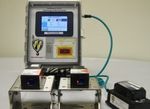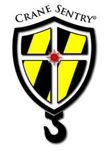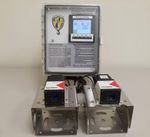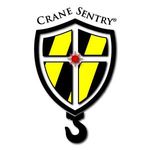Use of No-Fly Zones to Increase Safety and Reliability with Overhead Cranes
←
→
Page content transcription
If your browser does not render page correctly, please read the page content below
LASER-VIEW TECHNOLOGIES
No Fly Zones
Use of No-Fly Zones to Increase Safety
and Reliability with Overhead Cranes
In many heavy industries, overhead bridge cranes are a common tool
of the trade. Throughout the years, overhead cranes have also been
referred to as “EOT” cranes, which stands for Electrified Overhead
Traveling Crane. These cranes come in different configurations, but
what is common is that each crane commonly has one or more trolley
hoists mounted.
In low overhead situations, the hoist can interfere with structures
or equipment on the factory floor under the crane runway. Other
situations exist in which a die may need to be transported through the
facility and needs a clear path so that collisions will not occur. No-fly
zone systems add to a company’s safety program.
Definition of No-Fly Zones
A no-fly zone is an area in which you wish to prohibit overhead
crane movement. This area can be designated in several ways:
Prohibit movement of trolley hoist
Prohibit movement of bridge only
Force slow speed only whole in the zone either during all
operation or only when in override mode
What kind of obstacles warrant no-fly zones?
Buildings/structures within the crane runway
Equipment, such as stamping presses, CNC machine centers,
or injection molding presses
Areas with high material handling traffic below, such as main
forklift aisles
Other crane systems, such as modular self-standing cranes
under the main runway
Jib cranes for machine tending
205 Byers Road info@laser-view.com
Phone: 610-497-8910
Chester Springs, PA 19425 www.laser-view.comNO-FLY ZONE
Overview
No-Fly Zones are More Important Now Than Ever Before
As crane controls have migrated from pendent to wireless radio type controls, the frequency and probability
of collisions between a crane and obstacles have increased. This is because the crane operator no longer
must walk with the crane. In some cases, operators can mistakenly operate a different crane than intended.
Too often, he or she realizes this after it is too late.
Even the most experienced operator can easily become distracted during a crucial part of a lift and
miscalculate the position of the crane. If complacency kicks in and an operator does not feel the need
to operate slowly around an obstacle, a lift can go wrong once the load shifts unexpectedly. Laser-View
Technologies has witnessed more than once what happens after a crane loaded with steel coil plows
through an office or operator console. In the case referred to, the operator console/office has existed since
the facility opened!
Methods of Restricting Overhead Crane Movement in No-Fly Zones
Traditionally, no-fly zones have been handled using mechanical limit switches. These switches, often referred
to as “windmill” switches, are mounted to the bridge or trolley and fixed levers flip the positions.
The limit switches must be tied into a common controller to provide the relay logic for the forward, reverse,
and speed signals to the bridge and trolley drives. Adjustment is not easy, since any position adjustment
must be made mechanically by remounting and repositioning the trip arm. In addition, two switches are
needed to obtain slow and stop conditions on each of the four sides of the zone.
Non-contact methods using modern laser distance sensors
is a better technique for no-fly zones. This technique, when
integrated properly, provides almost infinite adjustment and
can easily be configured for your needs.
Implementation of such a system requires monitoring the
position of the bridge relative to the runway end stop or a wall
and the trolley relative to the end of the bridge. It is imperative
that you never lose position during operation. That is where
Crane Sentry® Zone Manager products really shine.
We use long range laser distance sensors with absolute
monitoring capability. Even if the laser signal is blocked or
moves on/off its target plate for a brief moment, the position
sensors will pick up its absolute position right away.
205 Byers Road info@laser-view.com
Phone: 610-497-8910
Chester Springs, PA 19425 www.laser-view.comCONSIDERATIONS
Design & Implementation
Design and Implementation Considerations for No-Fly Zone Systems
When considering a restricted zoning system for your overhead crane, it is important to understand how
your crane is utilized and to identify if the goal is personnel protection only or a combination of safety and
equipment reliability.
In what areas is the hoist prohibited?
Is the no-fly zone(s) permanent or do you need access to
this area at times for activity, such as machine maintenance?
Are there obstacles that interfere with the crane’s hoist or
bridge intermittently that need protection, like a robotic arm,
or a mast from a CNC machine?
Do you need override capability over the restricted areas?
Are there areas of your facility that the crane must always
enter, but you need a SLOW zone instead of a no-fly zone?
How many restricted zones are needed?
Other parameters that are crucial to the project:
Runway length and span
Type of crane drive… contactor, VFD, 250 VDC controls
How many independent trolley hoists are on each crane?
Radio controls or pendant controls
205 Byers Road info@laser-view.com
Phone: 610-497-8910
Chester Springs, PA 19425 www.laser-view.comOff-the-Shelf Pre-Engineered Solutions
for Overhead Crane No-Fly Zones
Next Generation Crane Sentry® Zone Manager II
Laser-View Technologies’ next generation Crane Sentry® Zone Manager II is made especially for advanced
no-fly zoning with overhead cranes. This product is an advancement on the popular Zone Manager system
that has already set the bar in the overhead crane industry for no-fly zoning. The new product improves
on the expandable capabilities of the system and permits remote configuration via a smartphone or tablet,
while still providing controls on board. Zone Manager is considered a “field mod” for crane dealers, as it is
easily retrofitted to existing cranes.
Crane Sentry® Zone Manager II provides systems that use long Accidental interference can lead to
range laser distance sensors in 2 axes capable of measuring up several problems:
to 500 meters. This technology provides an absolute position
that does not require mechanical positioning of limit switches or
re-zeroing of encoders. Injury to personnel
Damage to structure
Crane Sentry® Zone Manager provides an off-the-shelf system
Damage to tooling or materials being
for keeping EOT cranes from interfering with structures or
transported
equipment under a crane runway. Crane Sentry® provides highly
configurable systems that can prevent accidental damage to in- Downtime to evaluate the incident
plant building or machinery by creating no-fly zones around each
area.
With the Zone Manager, a virtual box is made around the
restricted zone using (2) laser sensor axis. Zone Manager
provides intuitive configuration, is easy to install, and provides
everything you need as a package.
Crane Sentry® Up to 8 zones in one 2 axis system
Zone Manager has Controls are housed in its own enclosure, ready to mount; remote access
the following key available through a smart device with no internet connection needed
advantages over Up to 500 meters of measurement range
the competition No reflector required for shorter runways
Visible red eye safe laser spot
This heart of our system is a robust measuring device and is not treated
as a proximity sensor – you read a live value and teach/enter actual set
points to determine zone perimeter
Live error handling algorithm
Built in override function
205 Byers Road info@laser-view.com
Phone: 610-497-8910
Chester Springs, PA 19425 www.laser-view.comImportant Key Characteristics
to Consider
To maintain safe operation of hoists, it is important that a no-fly zone system have key characteristics that
will promote safety and reliability:
Absolute positioning sensors that never lose track of the crane and never require re-zeroing
Configuration of zones and related slow buffers: Simple configuration of restricted zones and the related
parameters. It is imperative that a slow and stop zone be configurable.
User alarm configuration: The ability to set alarm limits is crucial.
Interface with machines in your facility: The ability to override a no-fly zone or alert a machine that the
crane is in its area.
Override capability: Overrides are often needed for maintenance access with the crane
Real measurement system: See the position values and don’t guess like a proximity system
Results of implementing no-
fly zone monitoring on your
overhead crane(s):
When you invest in a Crane Sentry® Zone Manager, you are doing
this to minimize the possibility of an accident and minimize the
frequency of repairs and related down-time. You should have
several expectations:
Limit the ability of an operator to collide with obstructions in areas that have been preconfigured as known
as restricted zones.
Adjust operator behavior and awareness so that they transport materials in safe and clear paths
Promote the modification of production processes in line with safe hoist practices.
Conclusion
As production demands increase, fast and efficient movement of materials
via overhead cranes is important. Handling materials around structures
and equipment in a facility poses an inherent risk to navigate the obstacles.
Experienced operators typically can navigate around the building or stamping
press in the middle of the runway, but it takes only the smallest distraction
for an accident to occur. Any accident involving collision between a crane and
a structure or machine can cause a reportable safety event, combined with
serious machine or load damage. Investing in reliable and simple technology,
such as Crane Sentry® Zone Manager can help in the quest to provide a safer
interface with cranes that also minimizes unplanned downtime.
205 Byers Road info@laser-view.com
Phone: 610-497-8910
Chester Springs, PA 19425 www.laser-view.comYou can also read


























































